Container shipping: volume growth calms, tariffs remain strong
Global growth in container shipping is expected to slow to 3% in 2022. Disruption in supply chains should persist amid the war in Ukraine and lockdowns in Shanghai. Consequently, squeezed capacity and elevated tariffs won’t be over before 2023
Strong rebound in container traffic pushes global ports far beyond pre-pandemic levels
Container shipping has enjoyed a phase of strong demand. With the exception of Hamburg and Hong Kong, the 15 largest container ports in the world exceeded pre-pandemic traffic levels in 2021, with flows in Chinese ports like Tianjin, Qingdao, Ningbo and Shenzhen seeing double-digit increases compared to 2019. Container throughput in the largest US ports ended up being 20% larger amid surging demand for goods last year.
The world's largest container ports expanded in 2021, the US is most busy
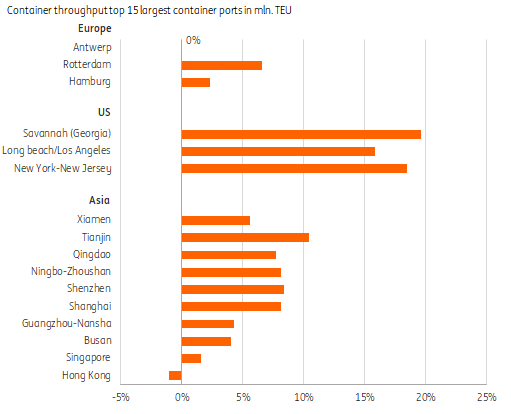
Slower container volumes in 2022 while market remains tight
Volumes in global container shipping and container ports are expected to slow to 3% (in MT). In the first three months of 2022, US ports operated at record levels which enabled them to cut backlogs. The largest global port, Shanghai, handled over 47mn containers. But the port has struggled amid new lockdowns in China, and a strict Covid policy remains a risk for terminal productivity in the country. In Europe, the largest ports will face sliding throughput because of the loss of Russian container volumes and diverted vessels because of delays.
Shanghai is by far the largest global port - lockdown to leave its mark
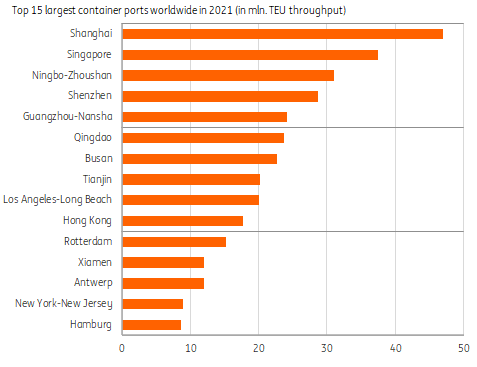
Relief in US port congestion but capacity pressure is far from over
Travel durations for containerised freight from the Far East to destinations in Europe and the US have increased. Timeliness still hovered around double the pre-pandemic level in April at over 100 days. In the most important port area and bottleneck in the US LA-Longbeach, the backlog dropped. At the same time, Western European ports face the consequences of stranded containers destined for Russia, which again pushes up congestion. And with China being the leading export country for consumer goods, the impact of disruption in Shanghai will leave its mark in other parts of the world through at least the second quarter. This adds to an already unbalanced system. On average, global port congestion was still close to peak levels in April, leading to delays and low arrival reliability.
Hardly any sign of improved arrival performance at the start of 2022
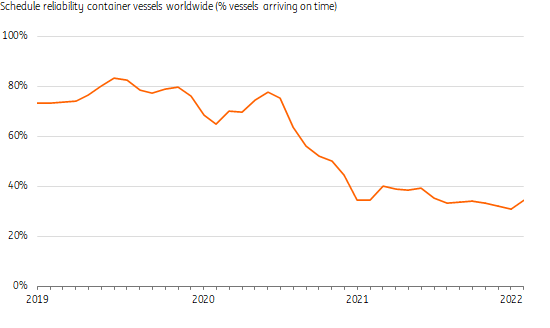
Spot rates ease at high levels while liners lock in higher rates for longer
Westbound spot rates from Shanghai to Europe eased from the peak seen in early 2022. Earlier imposed caps from carriers like Hapag Lloyd and CMA CGM, cooling world trade, as well as regular seasonal effects could be reasons behind this. However, in April, rates were still three to six times higher than normal and liners have been shifting more to long-term contracts with shippers seeking to secure higher rates for longer. In this regard, Maersk aims to reach 70% of total volume under its term contract in 2022, up from 49% in 2019.
Container spot rate tariffs from China-Europe eased from extremes, but remain high
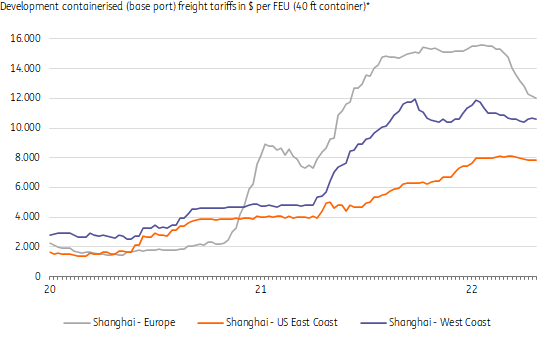
Lasting congestion and inefficiency lead to another strong year
Average containership earnings per day are still trading at peak levels in April and this is similar for the 6-12 month chartering of larger feeder vessels. Congestion still consumes over 10% of total fleet capacity and average port congestion has not improved either. This will mean that capacity pressure is set to remain and rates are expected to stay significantly higher than before. All in all, this will lead to another year of strong results for carriers in 2022 despite a much higher fuel bill.
Highly profitable years enable container carriers to take strategic steps
The large cash reserves will enable liners Maersk and CMA CGM to invest in their strategic development as integrated logistics services providers, by acquiring logistic services activities, investing in terminals and setting up a fleet of full freighters. The aim is to compete with players like Amazon or DHL as end-to-end logistics players, as well as possibly large shippers like Walmart, Ikea and Lidl which are trying to develop their own logistics activities. For logistics services providers, this creates a challenge.
Container liners exceptionally profitable in 2021
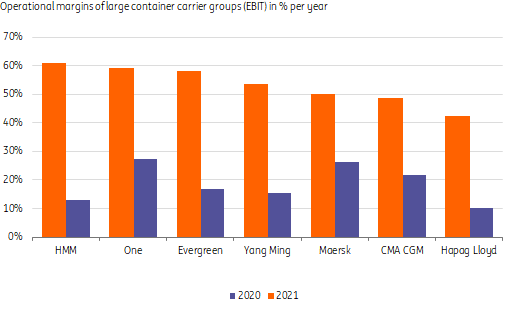
Wave of new container capacity in 2023-2024, but rates not expected to return to previous levels
In the market boom, container liners have ordered over 500 new vessels including (ultra) large ones with capacity from 15,000 to 24,000 twenty-foot equivalent units (TEUs). This amounts to over a quarter of the current fleet capacity in March. Most new container vessels will sail from 2023 and 2024 (both years +9%), creating much more capacity than can be instantly absorbed by demand growth. However, container rates are not expected to return to previous low levels any time soon for several reasons:
- Container liners have shifted massively to longer-term contracts locking in higher tariffs in the short run
- Container liners have learned how to manage capacity by taking sailings out of the loop. Slow steaming is another instrument to manage capacity
- The sector is more consolidated – three large alliances dominate* (80% market share)
- Fuel costs are higher and liners can reduce speed to save fuel or manage capacity: (super) slow steaming (blending) alternative fuel is more costly
- Carbon emissions will ultimately be priced
- More retrofits and scrapping are coming to meet CO2 targets.
*Because of the nature of the industry including large risks and longtime overcapacity, container liners have received waivers from authorities to operate in three large alliances. Questions have been raised around extreme profits In Europe and this block exemption is valid until 2024 but in the US, the functioning of the market will be investigated. However, the outcome is not clear.
How three of the largest container carriers have performed
CMA CGM
CMA CGM reported a strong increase in revenue and EBITDA for FY 2021. During the year, the company had revenues of $56.0bn, up 78% year-on-year, and EBITDA of $23.1bn, up 278% YoY, with a margin of 41.3% (vs 19.4% in FY 20). According to CMA CGM’s management, the financial performance reflected extremely strong demand conditions.
During 2021, CMA CGM’s Shipping division achieved a major increase in unit revenue, with the volumes shipped of TEU22.0mn, up 5% YoY, and revenue per TEU transported of $2,055, up 79.5% YoY, with significant rate increases on the Transpacific, Asia-North Europe and Latam routes. Unit revenues were also supported by higher contracted rates. The higher shipping rates more than offset an increase in unit costs, which were related to the congestion of the supply chain (handling and stevedoring, transportation, logistics), higher chartering costs and higher bunker consumption. In 2021, CMA CGM’s unit costs were up 18.2% YoY. The company’s Logistics business also showed an improvement in 2021, with revenues up 46.9% YoY and EBITDA up 43.6% YoY.
CMA CGM noted that disruptions in global supply chains have continued to constrain the effective capacity of the global fleet at the beginning of 2022 and that the company is closely monitoring developments related to the Russian war in Ukraine as it has suspended all bookings to and from Russia, Ukraine and Belarus. According to CMA CGM, congestion peaked in December 2021, while the company is still waiting for evidence of improvement so far this year. There was a strong start to this year, with dynamics broadly in line with trends seen in 4Q21, but with macro and geopolitical uncertainty on the rise. The company expects that the industry backdrop will continue to be supportive due to limited new vessel deliveries in 2022, combined with strong demand. Risks highlighted by CMA CGM are cost inflation, including elevated energy prices, and worsening geopolitical risks. The management expects the Q122 EBITDA to be in line with Q421. The company also expects that a higher proportion of contracted revenues at favourable rates should support the medium-term performance.
CMA CGM aims to keep investment at a high level, with total gross capex of $4.8bn in FY 21, including gross Shipping capex of $3.5bn and $1.1bn for Aircraft, Terminals and Other and $0.2bn for Logistics. Total capex budget for FY 22 is $4.5bn, including Shipping capex of $3.2bn, comprising newbuild orderbook and purchase of second-hand vessels ($2.3bn), fleet maintenance and modernisation ($0.5bn) and substantial increases in container fleet, as well as $1.0bn for Aircraft, Terminals & Other and $0.3bn for Logistics. Also, the 2022 M&A budget is $5.4bn, including $3.0bn for Shipping, $1.7bn for Logistics and $0.7bn for Aircraft & Terminals. Free cash flow after gross capex was a very substantial $14.8bn in FY 21.
To recap: (1) uncertain macro and geopolitical environment; (2) strong start to the year, in line with the 4Q trends; (3) demand backlog and contracted rates to support 2022 performance; (4) strong balance sheet and ample liquidity; (5) significant investment plan for 2022, with limited dividend payout ratio.
Hapag-Lloyd
Hapag-Lloyd had a strong year in 2021, with revenues of $26.4bn, up 81% YoY, and EBITDA of $12.8bn, up 317% YoY, with a respective margin of 48.7% (vs 21.1% in FY 20). During FY ‘21, the company shipped 11.8mn TEUs, flat (+0.3%) YoY, and freight rates of $2,003 per TEU, up 79.6% YoY. Hapag-Lloyd commented that the key drivers of this very strong performance included significantly improved freight rates stemming from very strong demand for goods exported from Asia. The increase in earnings and margins was achieved in spite of higher transportation expenses (up 17% YoY) due to higher bunker prices (+25% YoY) and charter rates as well as increased demurrage and storage fees. Free cash flow was $10.9bn in FY ‘21, leading to the company’s net leverage turning from the net debt of $5.5bn at YE ‘20 to the net cash position of $2.5bn at YE ‘21, in spite of the dividend distribution of $0.8bn during the year.
Since 2021, the company has been offering customers multi-year contracts at fixed rates in order to secure allocation and improve efficiency. The freight rate is fixed for the duration of the contract, avoiding market price fluctuations, such as during the past two years, with some overbooking (up to 10%) allowed in order to ensure an uptake of the agreed allocation. There is also compensation envisaged on the basis of failing to provide the contracted capacity.
Hapag-Lloyd indicated that it had a very strong start to this year and expected this positive earnings trend to continue in the first half of 2022. The company also commented that it expected the constrained situation in global supply chains to ease in the second half of this year which should then lead to the start of the normalisation of earnings. According to Hapag-Lloyd, it aims for an EBITDA range of $12 to $14bn, while this forecast is subject to a material uncertainty, including in relation to the war in Ukraine and the continued Covid-19 pandemic.
According to the company, while demand is expected to stay robust, the capacity influx will increase from 2023 onwards due to increased ordering activity and a substantial order book at the end of 2021.
In terms of the outlook for 2022, Hapag-Lloyd’s management expects volumes transported to increase slightly during the year, with bunker costs going up in a pronounced fashion, freight rates increasing moderately and EBITDA being in a similar ballpark to the prior year.
Maersk
In 2021, A.P. Moeller-Maersk (APMM) had a record financial performance, with revenues of $61.8bn, up 56% YoY, and underlying EBITDA of $24.0bn, up 189% YoY, with a respective margin of 38.9% (vs 20.9% in FY 20). In FY '21, APMM had free cash flow of $16.5bn, up from $4.6bn in the prior year. The company’s key operating segments include Ocean, Logistics, Services and Terminals, of which the Ocean (i.e., Shipping) is the most prominent. In FY ‘21, the Ocean segment generated revenues of $48.2bn, up 65% YoY, and EBITDA of $21.4bn, up 227% YoY, with a respective margin of 44.4%. Last year, the division’s loaded volumes increased by 3.6% YoY, while freight rate went up by 66% and bunker price per tonne increased by 30% YoY.
At the end of 2021, APMM had access to liquidity to the tune of $21.5bn and a net cash position of $1.5bn.
In terms of the outlook for 2022, APMM expects that it will have a strong first half of the year, followed by a normalisation in its Ocean business early in the second half of the year. The company anticipates that its shipping business will grow in line with the global container demand of +2% to +4% in 2022, subject to uncertainties related to the ongoing congestion, network disruptions and other external factors.
APMM also reiterated its adherence to its 2021-2025 roadmap, including achieving cross-selling synergies between its Ocean and Logistics & Services segments. This strategy is also supported by the company’s ongoing M&A activity.
Based on these assumptions, the company expects an underlying EBITDA of around $24bn, an underlying EBIT of $19bn and free cash flow above $15bn.
This publication has been prepared by ING solely for information purposes irrespective of a particular user's means, financial situation or investment objectives. The information does not constitute investment recommendation, and nor is it investment, legal or tax advice or an offer or solicitation to purchase or sell any financial instrument. Read more
Download
Download article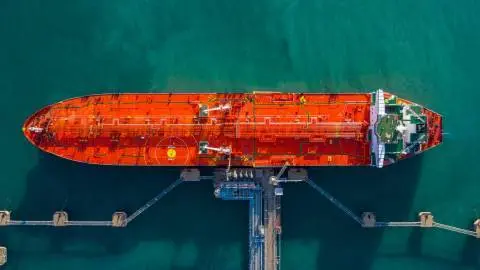
26 April 2022
ING’s global transport and logistics sector outlook This bundle contains 4 Articles
